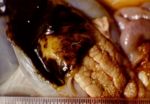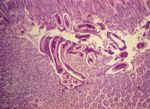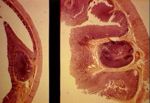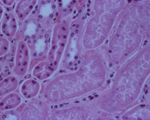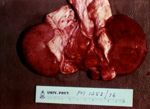Category:Enteritis, Catarrhal
General
- Catarrhal enteritis is particularly common in farm animals, especially in the first few days of life.
- The combination of the outpouring of protein rich fluid and low absorption produces rapid dehydration and often death.
- The causes are numerous - some are considered below.
Pathology
- Hyperaemia of the gut may be visible through the serosa, although there is no external damage.
- Blood vessels are obvious
- The whole bowel appears red looking, wet shiny and oedematous.
- Internally, the mucosa is oedematous with a mucoid appearance.
- The exudate is initially thin and watery (i.e. serous).
- The exudate becomes more mucoid and cellular as the condition progresses.
- Mucus coats the epithelial surface of the gut.
- As polymorphs enter the bowel contents, they may become quite opaque (i.e. mucopurulent).
- The exudate becomes more mucoid and cellular as the condition progresses.
- In older cases of catarrhal enteritis epithelial cells are lost.
- Villi become stubby.
- Mucosa may appear quite shiny.
Parasites
- This is the most important condition causing cattarhal enteritis worldwide.
- Seen mainly in grazing animals.
- Especially in sheep - causes large production losses.
- Particularly problematic since some parasites are resistant to anthelmintics.
- Especially in Australia.
- e.g. Nematodirus and Trichuris.
- A pre-patent period of 7-10 days is followed by the development of greenish diarrhoea.
- The gut becomes filled with greenish soupy material.
- Oedema and hyperaemia of mucosa occurs.
- In young animals, parasites can cause serious disease and even death.
Mixed viral enteritis
- Mixed viral enteritis is particularly prevalent in very young calves.
- It is predomintantly a management-related disease.
- Viruses initiate the disease, but some bacteria are involved.
Cattle
Undifferentiated Neonatal Calf Diarrhoea
- A syndrome with many causes.
Clinical
- Is seen mostly in calves between 1 and 28 days old.
- Known as "white scour".
- Has a high morbidity in calves that are doing well and feeding well.
- Large amounts of milk coloured diarrhoea.
- Tends to cover all over tail and hindquarters.
- Often produces skin sores.
- Tends to cover all over tail and hindquarters.
- Condition is lost quite quickly, and a high mortality may be caused.
Pathogenesis
- Certain conditions predispose calves to undifferentiated neonatal calf diarrhoea.
- Stress
- Insufficient colostrum
- Cold milk
- Mixing strange calves together after separating from mother.
- A mixture of viruses and bacteria are involved, some more commonly than others.
- Undifferentiated neonatal calf diarrhoea is, however, a primarily viral disease.
- Some of the agents below are also found also in perfectly normal calves.
- Other viruses not listed are also probably involved.
- The exact cause is not always important, since are cases all treated in the same way.
| Virus | % Cases | Bacterium | % Cases |
|---|---|---|---|
| Rotavirus | 40% | Cryptosporidium | 20% |
| Coronavirus | 20% | Enterotoxigenic E.Coli | 20% |
| Infectious bovine rhinotracheitis virus | 4% | Campylobacter | 30-40% |
| Calici-, parvo-, adeno-, viruses | 1% each |
- The condition has a very characteristis appearance on post mortem examination.
- The intestine is filled with gas and foam, and possibly flakes of milk.
Winter Dysentery
- Sporadic, acute, bloody diarrhoea in adult cattle
- Bovine coronavirus
- Worldwide distribution
- Dramatic decrease in milk yields, less common in beef cattle
Pigs
- Pigs are particularly susceptible to a number of specific enteric viruses.
- Especially coronaviruses.
- These may produces outbreaks on a whole farm basis in all ages of pigs.
- Especially coronaviruses.
Transmissible Gastro-Enteritis (TGE)
Bacterial enteritis
Colibacillosis
- The enteritis caused by colibacillosis is relatively mild although the diarrhoea can be severe.
- Only a few strains of coliform organisms cause disease.
- These are identified by their serotypes.
Pathogenesis
- There are three mechanisms by which coliform organisms cause diarrhoea.
Enterotoxigenic E. Coli (ETEC)
- Cause neonatal and post-weaning diarrhoea in ruminants and pigs.
- In calves, ETEC are only seen in animals of 4-5 days, or possibly up to one week, of age.
- If the animal is older than 1 week, the agent is NOT ETEC.
- Housed lambs may also suffer from ETEC.
- Animals are usually under 1 week old.
- Sheep do not suffer as commonly as calves, as they are normally better managed.
- Pigs less than 1 week of age may suffer.
- In calves, ETEC are only seen in animals of 4-5 days, or possibly up to one week, of age.
- Bacteria adhere to enterocyte receptors using pili e.g. K87 (Especially in pigs), K88, K99 (especialoly in cattle).
- Toxins produced by the bacteria encourage loss of Cl-, Na+ and water in gut secretions.
- Causes diarrhoea and dehydration.
- Death is a result of dehydration and electrolyte loss.
- Toxins produced by the bacteria encourage loss of Cl-, Na+ and water in gut secretions.
- To be pathogenic, ETECs require 2 qualities not found in non-pathogenic coliform organisms.
- Adherence factors.
- Heat stable toxins.
- Control is by management factors, such as hygiene, good colostral intake and so on.
- There is the potential in the future to breed from pigs that lack adherence antigen sites for E.coli.
Enteroinvasive E. Coli
- Not common in animals!
- These strains act like shigella or salmonella.
- Penetrate enterocytes, invade lamina propria and spread to lymph nodes and beyond.
- Toxin damages enterocytes, causing:
- Blunting of villi.
- Elongation of crypts.
- Sometimes mucosal ulceration.
Enteropathogenic (attaching and effacing) E. coli
- Penetrate glycocalyx, adhere closely to mucosal cell surface and destroy the microvilli.
- Cause:
- Blunting of villi.
- Crypt hypertrophy.
- Inflammatory cells in the lamina propria.
- The colon is often more severely affected than the intestine.
- Septicaemic coliform infections may also occur.
- Mainly in first 2 days of life.
- usually due to insufficient colostrum intake.
- Produce peracute death without diarrhoea.
- Mainly in first 2 days of life.
Pathology
Gross
- Gut loops filled with gas and fluid.
- Gut contents are mucoid.
- Gut wall is flaccid.
- Mild congestion.
Histological
- Bacteria on epithelial surface.
- Mild inflammation in the lamina propria.
- More severe lesions e.g. villus atrophy are rare.
Treatment
- It is pointless to try to kill the organism in this disease.
- Treat the effects of the disease instead.
- Fluid replacement therapy.
- Produces a quite good and quick recovery, especially in calves.
- Fluid replacement therapy.
Enterotoxaemias - Bacterial Diseases
- Many bacteria produce toxins that are often responsible for clinical effects.
- e.g. oedema disease due to E. Coli.
- Toxin is produced in the gut but is absorbed into the circulation to take effect elsewhere.
- e.g. oedema disease due to E. Coli.
- Systemic effects of these toxins may kill the animal.
- Systemic toxicosis derived from organisms in the alimentary tract is also seen with the Clostridia group of bacteria.
"Pulpy kidney" Disease
- Caused by Clostridium welchii / Clostridium perfringens type D.
- The organisms are found everywhere cannot be got rid of.
- Found in the soil and as a gut commensal, but can explosively multiply and produce toxin under certain conditions.
- Often occurs when the animal had just changed from one feed to another (i.e. just put out onto lush grass).
- Seen mostly in sheep and goats.
- Disease was commonly vaccintated against, but this may not be done in times of financial difficulty.
- Diagnosis of the disease is important in deciding if should sheep be vaccinated.
- If the animal has been vaccinated it is important to need to diagnose pulpy kidney accurately in case of possible legal proceedings.
- Diagnosis of the disease is important in deciding if should sheep be vaccinated.
- Disease was commonly vaccintated against, but this may not be done in times of financial difficulty.
Clinical
- The time course from onset to death is only a few hours, so sheep are normally found dead and only occasionally seen alive.
- Nervous signs, such as head pressing, may be seen.
- Paralysis of the oesophagus may result in severe bloat.
- Profuse greenish diarrhoea is seen occasionally just before death.
- Only mild catarrhal enteritis is seen in the gut.
Pathogenesis
- Lesions due to effect of epsilon toxin on blood vessels.
Pathology
- Animals are very bloated.
- Often lack lesions.
- Guts appear slightly flaccid, and a bit hyperaemic.
- The toxaemic carcase has petechial and echymotic haemorrhages, and hydropericardium.
- The kidneys are characteristically affected.
- Become oedematous, mushy and red within about 1 hour of death.
- A stream of water on cut surface of the kidney washes away the epithelium (since it is necrotic) and leaves fronds of tissue (This is the case with any kidney if the post mortem is more than a few hours after death).
- This accelerated post mortem change is a characteristic of the disease.
- Glycosuria is a feature
- The toxin affects the epithelium of the proximal part of nephron, stopping resorption of glucose.
- Note: the swelling of cells in the kidney means that anuria occurs, meaning there is no urine avaialable to rest for glucose.
- It is sometimes possible to get a positive reaction to a stick test by wiping it on the inside of the bladder.
- Periportal hepatic fatty change occurs.
- This is only really seen histologically.
- Grossly, the liver looks "half cooked", but this is true of many bacterial diseases.
- Histopathology is often not helpful.
- Necrosis of cells in proximal convoluted tubules.
- There is also a characteristic degeneration in parts of the brain - focal symmetrical encephalomalacia
Diagnosis
- Location of the organism in the gut contents is not helpful, since it is always present (as a commensal).
- Therefore, diagnosis is by location of the toxin in the gut contents.
- Toxin is tested for by administering filtered intestinal fluid intravenously to a mouse (mouse protection test).
- If the toxin is present, the mouse should die within minutes or hours.
- Another mouse can be protected from the effect of the toxin with a specific antibody.
- An ELISA test is also possible.
- However, an ELISA is often too sensitive as the toxin can be present in the normal sheep gut and the ELISA can pick this up.
Pages in category "Enteritis, Catarrhal"
The following 7 pages are in this category, out of 7 total.
